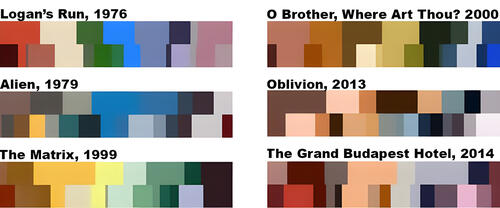
Computer scientists paint a picture of six decades of movies
Researchers say data science may eventually help predict a film’s success

Researchers say data science may eventually help predict a film’s success
By Media relationsFrom the sepia tones of a Coen brothers film set in the Dust Bowl to a child’s red coat in Schindler’s List, filmmakers have long known the power of colour in movies. Now, computer scientists have analyzed 60 years of films to paint a picture of the past six decades in film.
Researchers at the University of Waterloo used a technique called k-means clustering to analyze the trailers for more than 29,000 North American movies released between 1960 and 2019.
“We chose to analyze trailers because they typically include many key moments from a film while also being short and accessible to the public,” said Andreea Pocol, a PhD candidate in computer science at Waterloo and co-author of the study. “Trailers give us a reliable snapshot of a film, so we can extract a lot of data efficiently.”
Their technique produced both more general eight-colour palettes and more detailed 15-colour palettes, demonstrating the dominant colours for different data sets, which included specific films, genres and decades. They used the method to generate palettes for individual films—The Shining or The Matrix, for example—as well as groups of films, such as science fiction films or those released between certain dates.

Eight- and 15-colour palettes from films of different genres and eras.
Notably, their algorithm improved on earlier analytical methods by eliminating skin tones and the grey of asphalt in order to more accurately represent the memorable colours used in films.
The researchers found specific colours are prevalent in certain genres. As one might expect, the palette for westerns demonstrates that directors use the same muted earth tones regardless of era, while science fiction uses a lot of neon green.
“While movies in the 1960s and 1970s tended to use more saturated primary colours, the team’s analysis demonstrates modern technology has actually allowed directors to use a wider variety of colours in creative ways,” Pocol said.
The team’s ultimate goal is to use data science to help film industry executives understand trends in movie-making, including perhaps one day helping to predict a blockbuster or a flop.
“Computer science can improve the process of film production by offering tools that can help us know whether a film will succeed,” said Lesley Istead, adjunct assistant professor of computer science at Waterloo and assistant professor at the Carleton School of Information Technology. “Part of that process is just getting a better understanding of film itself.”
The study, The Colour of Horror, appears in the Proceedings of the 19th ACM SIGGRAPH European Conference on Visual Media Production.

Read more
Here are the people and events behind some of this year’s most compelling Waterloo stories

Dr. Chris Bauch, a professor of Applied Mathematics at the University of Waterloo, is part of a team that has developed a new approach to help public health officials predict where outbreaks might occur. (Elisabetta Paiano/University of Waterloo)
Read more
New research demonstrates that vaccine skepticism on social media can predict public health crises

Read more
Waterloo researcher Cameron Seth is breaking down the world’s hardest computer science problem piece by piece
The University of Waterloo acknowledges that much of our work takes place on the traditional territory of the Neutral, Anishinaabeg, and Haudenosaunee peoples. Our main campus is situated on the Haldimand Tract, the land granted to the Six Nations that includes six miles on each side of the Grand River. Our active work toward reconciliation takes place across our campuses through research, learning, teaching, and community building, and is co-ordinated within the Office of Indigenous Relations.